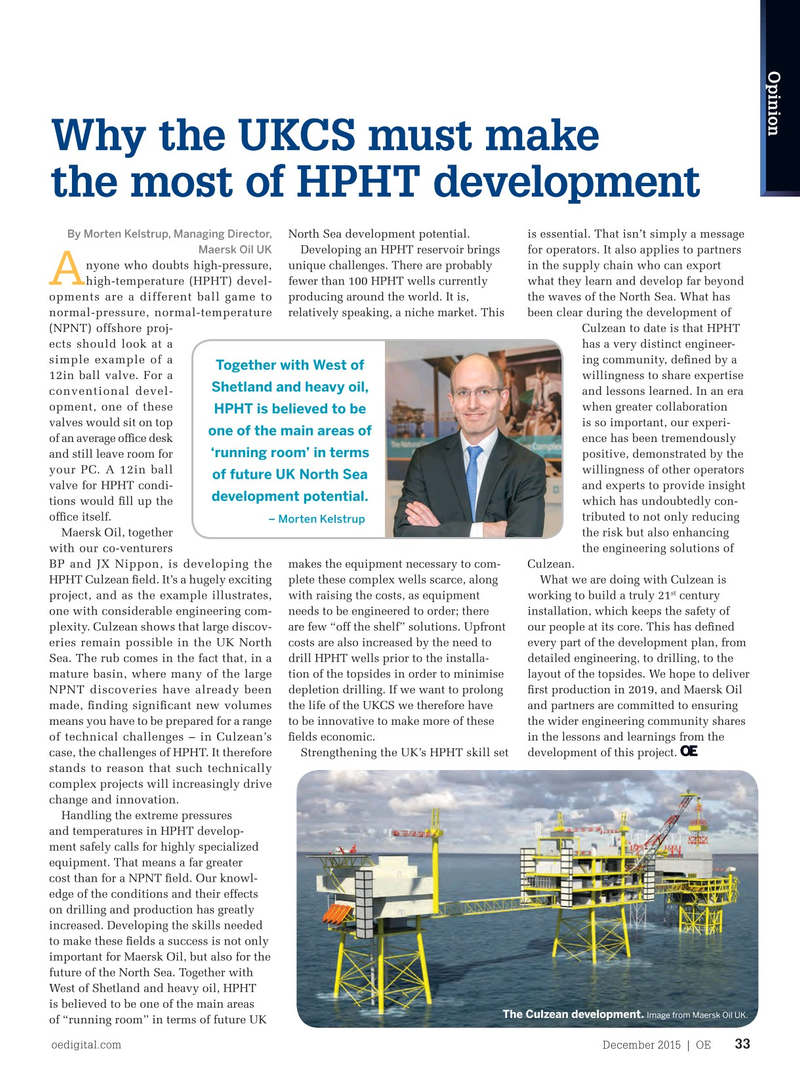
Page 31: of Offshore Engineer Magazine (Dec/Jan 2015)
Read this page in Pdf, Flash or Html5 edition of Dec/Jan 2015 Offshore Engineer Magazine
Opinion
Why the UKCS must make the most of HPHT development
By Morten Kelstrup, Managing Director,
North Sea development potential.
is essential. That isn’t simply a message
Maersk Oil UK
Developing an HPHT reservoir brings for operators. It also applies to partners nyone who doubts high-pressure, unique challenges. There are probably in the supply chain who can export
A high-temperature (HPHT) devel- fewer than 100 HPHT wells currently what they learn and develop far beyond opments are a different ball game to producing around the world. It is, the waves of the North Sea. What has normal-pressure, normal-temperature relatively speaking, a niche market. This been clear during the development of (NPNT) offshore proj-
Culzean to date is that HPHT ects should look at a has a very distinct engineer- simple example of a ing community, defned by a
Together with West of 12in ball valve. For a willingness to share expertise
Shetland and heavy oil, conventional devel- and lessons learned. In an era opment, one of these when greater collaboration
HPHT is believed to be valves would sit on top is so important, our experi- one of the main areas of of an average offce desk ence has been tremendously ‘running room’ in terms and still leave room for positive, demonstrated by the your PC. A 12in ball willingness of other operators of future UK North Sea valve for HPHT condi- and experts to provide insight development potential.
tions would fll up the which has undoubtedly con- offce itself.
tributed to not only reducing – Morten Kelstrup
Maersk Oil, together the risk but also enhancing with our co-venturers the engineering solutions of
BP and JX Nippon, is developing the makes the equipment necessary to com- Culzean.
HPHT Culzean feld. It’s a hugely exciting plete these complex wells scarce, along What we are doing with Culzean is st project, and as the example illustrates, with raising the costs, as equipment working to build a truly 21 century one with considerable engineering com- needs to be engineered to order; there installation, which keeps the safety of plexity. Culzean shows that large discov- are few “off the shelf” solutions. Upfront our people at its core. This has defned eries remain possible in the UK North costs are also increased by the need to every part of the development plan, from
Sea. The rub comes in the fact that, in a drill HPHT wells prior to the installa- detailed engineering, to drilling, to the mature basin, where many of the large tion of the topsides in order to minimise layout of the topsides. We hope to deliver
NPNT discoveries have already been depletion drilling. If we want to prolong frst production in 2019, and Maersk Oil made, fnding signifcant new volumes the life of the UKCS we therefore have and partners are committed to ensuring means you have to be prepared for a range to be innovative to make more of these the wider engineering community shares of technical challenges – in Culzean’s felds economic. in the lessons and learnings from the case, the challenges of HPHT. It therefore
Strengthening the UK’s HPHT skill set development of this project. stands to reason that such technically complex projects will increasingly drive change and innovation.
Handling the extreme pressures and temperatures in HPHT develop- ment safely calls for highly specialized equipment. That means a far greater cost than for a NPNT feld. Our knowl- edge of the conditions and their effects on drilling and production has greatly increased. Developing the skills needed to make these felds a success is not only important for Maersk Oil, but also for the future of the North Sea. Together with
West of Shetland and heavy oil, HPHT is believed to be one of the main areas
The Culzean development. Image from Maersk Oil UK.
of “running room” in terms of future UK oedigital.com December 2015 | OE 33 033_OE1215_HPHT3_Maersk opinion.indd 33 11/20/15 6:50 PM

 30
30

 32
32